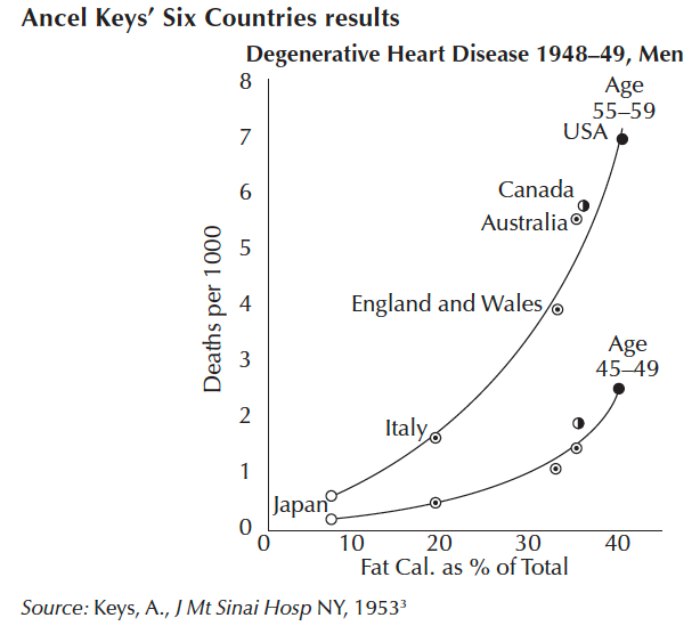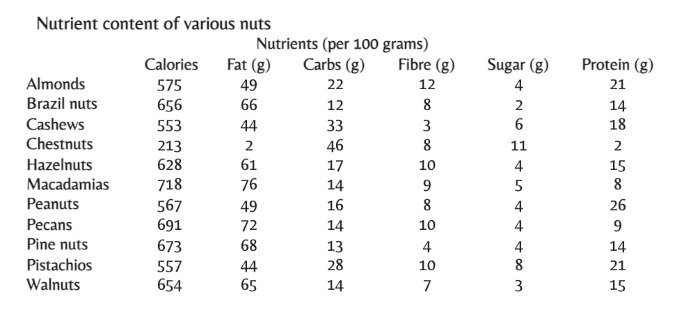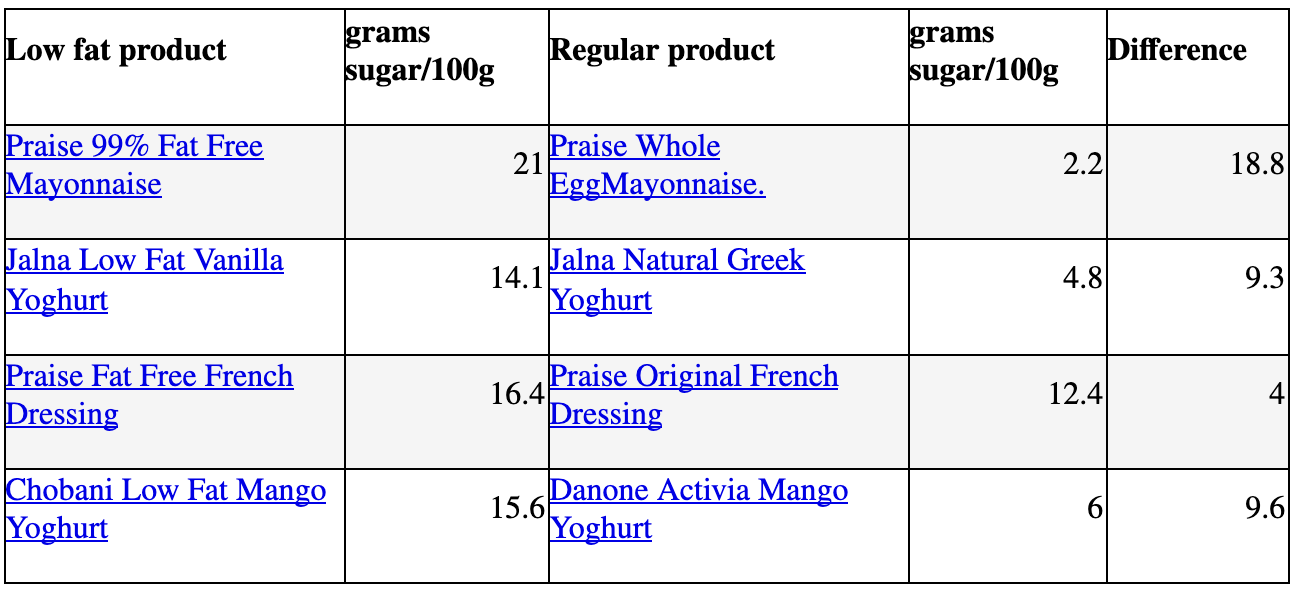This post originally appeared on Defeat Diabetes, Australia's leading program to send pre-diabetes and type 2 diabetes into remission, and is republished with their permission.
The world is in the midst of a rash of health epidemics. Seventy years ago, obesity was relatively rare, type 2 diabetes levels were low, dental cavities were uncommon, no one had ever heard of fatty liver disease, cardiovascular disease was almost unheard of, and people died from infectious diseases, not chronic disease.
Before the 1950s, few people had heart attacks, but during that decade the incidence of heart attacks started to increase. When US President Dwight Eisenhower suffered a heart attack in 1955, the public started to be concerned.
Two competing heart disease theories
At the time there were two competing theories as to the cause of narrowing or hardening of the coronary (around the heart) arteries, the medical term for which is atherosclerosis, which leads to a heart attack or myocardial infarction. One was that consumption of saturated fat was the major cause, the other was that sugar was the culprit.
In Britain, Professor John Yudkin was convinced that excess sugar intake was the cause of the heart disease epidemic. When he looked at the data on heart disease, he was struck by its correlation with the consumption of sugar, not fat. He carried out a series of laboratory experiments on animals and humans, and observed, as others had before him, that sugar is processed in the liver, where it turns to fat before entering the bloodstream.
He noted, too, that while humans have always been omnivorous, carbohydrates only became a major component of our diets 10,000 years ago, with the advent of mass agriculture. Sugar – a pure carbohydrate, with all fibre and nutrition stripped out – has been part of Western diets for just 300 years; in evolutionary terms, it is as if we have, just this second, taken our first dose of it.
Saturated fats, by contrast, are so intimately bound up with our evolution that they are abundantly present in breastmilk. To Yudkin’s thinking, it seemed more likely that the recent innovation, rather than the prehistoric staple, was making us sick.
In 1972, the year his convincing book for the general public, Pure, White and Deadly, was published, Yudkin was unequivocal in his opinion of sugar: ‘If only a small fraction of what we know about the effects of sugar were to be revealed in relation to any other material used as a food additive, that material would promptly be banned.’
Meanwhile, on the other side of the Atlantic, American researcher Ancel Keys was promoting his diet–heart hypothesis on the basis of two studies: his Six Countries Study, which he claimed showed that consumption of fat was related to death from heart disease; and his Seven Countries Study, which narrowed the culprit down to saturated fat.
And the winner is . . . low-fat!
The story of how Keys’ low-fat movement won out over Yudkin’s low-sugar recommendation is a fascinating web of intrigue and corruption, documented thoroughly by Nina Teicholz in her excellent book The Big Fat Surprise.
Keys first presented his data from the Six Countries Study at a symposium at Mount Sinai Hospital, New York, in January 1953 and it was published later that year in a paper entitled ‘Atherosclerosis: a problem in newer public health’. This was the first time Keys presented a graph (below) of the relationship between death from degenerative heart disease and fat calories as a percentage of total calories in the diet in men aged 45–49 and 55–59 in six countries: Australia, Canada, England and Wales, Italy, Japan and the United States. The six data points suggested a strong relationship between fat calories as a percentage of dietary intake and deaths from heart disease for men aged 55–59.

Keys concluded from this graph, ‘Whether or not cholesterol, etc., are involved, it must be concluded that dietary fat somehow is associated with cardiac diseases mortality, at least in middle age.’ Keys presented his graph of six countries with this explanation: ‘So far it has been possible to get fully comparable dietary and vital statistics data from six countries.’
It turned out that data were actually available at that time for 22 countries, not six. The researchers who uncovered it concluded: ‘It is immediately obvious that the inclusion of all the countries greatly reduces the apparent association.’
In 1956 Keys then embarked on his major study, the Seven Countries Study. Sixteen groups (cohorts) from seven countries were chosen: the United States (one cohort), Finland (two), the Netherlands (one), Italy (three), the former Yugoslavia (five), Greece (two) and Japan (two). Across these 16 cohorts, 12,770 men, aged 40–59, were studied (no women).
By the time the study was published in 1970, Keys no longer thought that total fat and heart disease were even associated. The Seven Countries Study concluded that saturated fat specifically was the single dietary culprit in heart disease.
The Seven Countries Study has been criticised on many counts. On the basis of his previous Six Countries data, and falling victim to confirmation bias, Keys was aware which countries were likely to provide data that supported his hypothesis that fat was the key factor in the development of atherosclerosis. The study also had many methodological flaws, which should really have meant that its findings were dismissed.
Instead, despite a number of other studies with better methodology that did not show a similar relationship between saturated fat and heart disease, Keys’ study became orthodoxy. It was the key justification for the American Heart Association (AHA) to declare in 1961 that saturated fats were bad because they increased blood cholesterol, which blocked coronary arteries and caused heart attacks.
So what happened next?
The food industry then got in on the action. Vegetable oils started being manufactured in the millions of tons. Leading them all was Procter & Gamble, which began to aggressively market cottonseed oil – as well as making a sizeable donation to the AHA, an amount worth $20 million today.
After Keys, the next key player in this game was Harvard nutritionist Mark Hegsted, an ardent advocate of reducing fat intake as a means of tackling heart disease – although he recognised that this view was controversial. In 1977, the US government released its Dietary Goals for the United States, the result of a US Senate select committee examination of the American diet. Although these guidelines were drafted by a researcher, Nick Mottern, he relied almost entirely on the advice of Hegsted. At the press conference announcing the first draft of the document, Hegsted stated: ‘The question to be asked is not why should we change our diet but why not? . . . There are (no risks) that can be identified and important benefits can be expected.
The role of the sugar industry
In 2016, documents were released that describe how industry sought to influence the scientific debate over the dietary causes of heart disease in the 1950s and 1960s. The sugar industry’s major body, the Sugar Research Foundation (SRF), was especially concerned about emerging research indicating an association between the level of blood glucose and the incidence of heart disease.
A 1965 editorial in the New York Herald Tribune concluded that the new research strengthened the case that sugar increased the risk of heart attacks.
As a direct result of this editorial, the SRF established Project 226 with the intention of countering the threat to the sales of sugar. In July 1965, Mark Hegsted and his Harvard colleagues were generously commissioned by the SRF to produce a review of the existing evidence, with the aim of ending all doubt and showing that sugar was “innocent”.
The review, published in July–August 1967 in the New England Journal of Medicine, concluded: ‘a lowering of the proportion of dietary saturated fatty acids, increasing the proportion of polyunsaturated acids and reducing the level of dietary cholesterol are the dietary changes most likely to be of benefit’.
In other words, saturated fat was denigrated while sugar did not even rate a mention. When the conclusions were reported by the media, saturated fat became public enemy number one. From this point on, the U.S. dietary guidelines reflected the paper’s conclusions.
Several biases coloured the results of this review. At the behest of the SRF, the most anti-sugar papers weren’t included or considered, and the researchers played down links between sugar and heart disease while stressing those between heart disease and saturated fat. Most significantly, this review both directly and indirectly influenced public health policies for decades.
More recently still, further evidence has emerged of the role of the SRF. In 1968 the SRF funded a research project on animals to shed light on the connection between sugar and heart health. But when the research pointed to a mechanism by which sugar might promote not only heart disease but also bladder cancer, the industry group ended the study and never published the results.
Hidden studies
Another tactic used by proponents of the diet–heart hypothesis was not to publish research findings that did not support their view – and that they therefore didn’t want doctors and members of the public to know. The ongoing Framingham Heart Study, which began in 1948, has been recording the consumption of dietary fats and the development of heart disease among more than 5,000 inhabitants of Framingham, Massachusetts. After the initial study period, the investigators found no correlation between fat intake, cholesterol and heart disease. These data, however, were never published.
As George Mann, one-time associate director of the Framingham Study later wrote: ‘The diet/heart hypothesis has been repeatedly shown to be wrong, and yet, for complicated reasons of pride, profit and prejudice, the hypothesis continues to be exploited by scientists, fund-raising enterprises, food companies and even government agencies. The public is being deceived by the greatest health scam of the century.’
Recently scientists have revisited data from two large unpublished studies from 1966–73. In the first of these, doctors intervened in the diets of a random selection of about 2500 people from the 9000 recruited for the Minnesota Coronary Experiment from mental institutions and nursing homes. For this group the saturated fats in their diet were replaced with polyunsaturated vegetable oil while a control group of similar size continued with their usual diet. Both groups continued for at least a year.
Recently, a group of investigators were able to obtain the raw data, which had never been published. The autopsy reports from the 140 deaths that occurred during the study revealed that 42 per cent of the people in the polyunsaturated fat group had suffered a heart attack, compared with only 22 per cent in the control group. The amount of atherosclerosis in the coronary arteries was similar for both groups. While those eating polyunsaturated fat showed a 13 per cent reduction in blood cholesterol levels, the death rate in those over 65 years was 30 per cent higher. Would it surprise you to learn that the principal investigator in the Minnesota Coronary Experiment was Ancel Keys?
The second study, which took place between 1966 and 1973, is known as the Sydney Diet Heart Study. In this research, about 220 men aged 30–59 were instructed to reduce saturated fat intake and increase polyunsaturated fat intake. The men were supplied with safflower oil and safflower oil-based margarine (both rich in the omega-6 fat known as linoleic acid). A similar number of men got no dietary instruction and acted as controls.
In the results of this study, reported in 1978, the men who cut back on saturated fat and boosted their omega-6 intake were found to be at increased risk of all-cause death. For some reason, the effects of the diet on risk of death specifically from cardiovascular disease (including heart disease) were not reported. When the researchers many years later went back to the old data to extract this information, they discovered that the men eating the ‘heart-healthy’ diet were at increased risk of dying from cardiovascular disease and heart disease (increases of 70 and 74 per cent respectively). So, the very diet designed to reduce the risk of heart disease and fatal heart attack was found to have the opposite effect: it killed men, and specifically from heart disease.
Over the years, a nexus of industry, medical organisations and doctors supported by industry has promoted the diet–heart hypothesis. Industry has also continued to try and influence policy. In 2015, it was revealed that a group called the Global Energy Balance Network, which had repeatedly played down the link between soft drinks and obesity, was secretly founded and funded by Coca-Cola. It was forced to close after emails showed the extent of the relationship.
So for reasons that had little to do with medical science but plenty to do with money, power and politics, Ancel Keys’ diet–heart hypothesis has formed the basis of dietary policy for the past 30 years.
And what has been the result? We have been getting fatter and sicker all that time. Maybe it is time to re-think?
Join Australia's leading evidence-based and doctor-led program transforming the health of Australians. Start your free trial of the Defeat Diabetes Program today.







